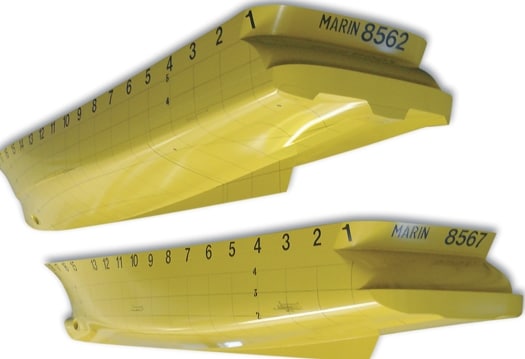
ytgnov17perf525.jpg
In an 1896 article, American architect Louis Sullivan opined that “form follows function,” but for us, it could be said that function follows form-hull form, that is. The form of the hull largely determines the functional limits of a yacht. There are round-bellied displacement hulls for going through the water and sharp-chined planing hulls for skimming over the water. In between are hulls that are variously referred to-correctly or incorrectly-as semi-displacement, semi-planing, or high-speed displacement hulls.
You might have heard that displacement hulls are slow and planing hulls are fast, but that’s only partially true. These hull forms are not defined by absolute speed ranges, but rather by their underwater shape. Hull shape is important to speed boundaries, but equally so is hull length.
Let’s take a look at the effect of length, illustrated by one of the fastest monohull vessels of all time, at least for sustained speed. This was not a yacht or a race boat, but rather the passenger liner SS United States. On her maiden voyage in 1952 she set a record in both directions crossing the Atlantic. The speed of this pure displacement hull was measured at an official 38.3 knots, with unofficial reports of a top speed in excess of 40 knots. That’s faster than many modern sportfishing yachts and faster than most so-called high-speed motoryachts, which invariably have planing hulls. How’d the SS United States do it? Length and horsepower.
In deciding on a hull form, naval architects deal less with absolute speed than with what they call the speedlength ratio. Speed-length ratio is the vessel speed in knots, divided by the square root of the waterline length. Experts disagree somewhat on the category limits, but displacement hulls generally operate at speed-length ratios less than 1.34 (also referred to as hull speed), planing hulls are suitable for ratios above 2.5 (some say 3.0), with the other hull forms falling into the gap between 1.34 and 2.5.
Let’s look first at the SS United States, which had an overall length of 990 feet. Allowing for a bit of bow rake and an overhanging cruiser stern, her waterline length would be about 960 feet. The square root of 960 is 31, and 31 x 1.34 equals 41.5. This means that she was capable of 41.5 knots with a displacement hull. Given her horsepower, could she have gone faster with a semi-displacement or planing hull? No, because when operating at less than hull speed, as the famed liner was, nothing is more efficient than a displacement hull.
Now let’s look at three smaller vessels: a trawler yacht, a sportfisherman, and a motoryacht, each about 70 feet overall and with a waterline length of 64 feet. Because she’s focused on long-range cruising, looking for maximum range for a given fuel capacity, the owner of the trawler yacht is going to opt for a displacement hull. The hull speed will be the square root of 64, which is 8.0 x 1.34. This yields a top speed of 10.7 knots, and results in very efficient cruising at 9 knots or so.
The sportfishing enthusiast wants to cruise at least 30 knots, with a top end of around 40 knots, and he’s willing to pay for the fuel and horsepower to achieve that performance. With that same 64-foot waterline, the equivalent of 40 knots is a speed length ratio of 5.0, and even 30 knots equates to 3.75, well above our lower limit of 2.5 for planing hulls. That’s exactly why you’ll find a planing hull under every modern sportfishing boat out there.
Our third yachtsman, the motoryacht owner, likes to cruise with his family. He’s looking for a reasonable turn of speed, to make the most of his free time, and a safety margin when the weather turns ugly. He’d also like to conserve fuel, however, and extend his range as much as possible. A top speed of 18 knots would be nice, but he’ll usually run at about 14 knots. That’s a speed-length ratio of 2.25 wide open, and 1.75 for cruise, falling nicely into our semiplaning category.
Adding more horsepower to a displacement-hulled trawler won’t boost its top speed, but a longer hull will. Likewise, that family cruiser could make the cited speeds with a displacement hull rather than semi-displacement if it grows from motoryacht to superyacht. As for the sportfishing machines, they’re committed to planing hulls, at least until they inch toward that 1,000-foot mark.









